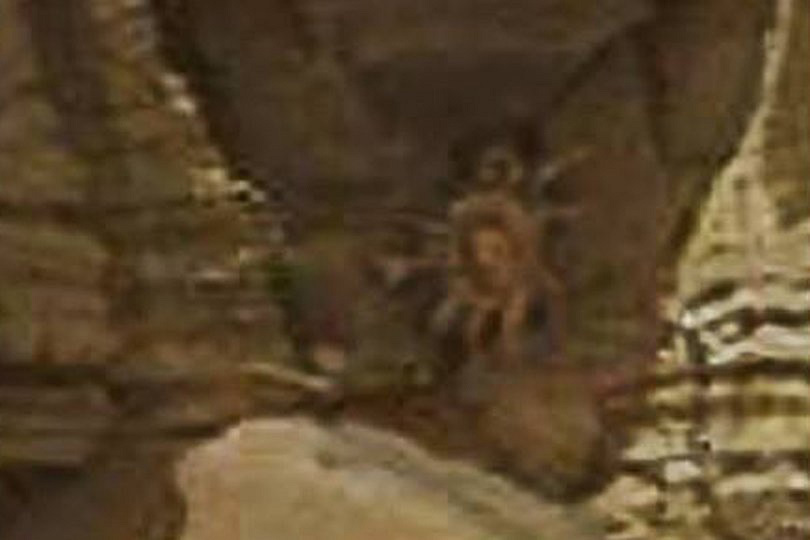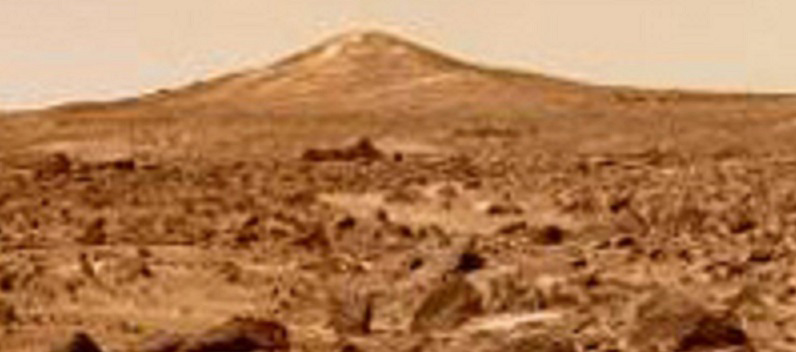Don’t Tell Me the Red Planet Wasn’t Once a Thriving World!

Today, I thought I would share with you some of the photos taken by NASA of Mars that strongly suggest there is life (or was life) on the Red Planet. We will begin with what has been termed “The Crowned Face.” A photo taken in the Libya Montes area – a ring of mountains on Mars – by the Mars Global Surveyor appears to show a large face, with a pointed chin, a pair of eyes and a nose. Also, what appears to be crown-like headgear – hence the name that has been attached to it, – whatever “it” may be. On this case, I’m sure the “face” was carved and not the equivalent of a dog’s face in the clouds. I’m convinced that it shows evidence of huge, mega-sculpting of the landscape. I definitely think it is well worth tackling this enigma to a greater degree. I should stress that Mars expert Tom Van Flandern was quite enthusiastic about the discovery: “While not near the Cydonia area, this face portrayal is again striking for the richness of its detail, far better than the typical face arising in clouds or geological formations on Earth. The latter tend to be distorted and grotesque when they are more than simply impressionistic.” It almost makes me think of the final minutes of the original 1968 movie, Planet of the Apes. You know what I mean. Now, let’s have another intriguing photo from Mars.

Now, let us take a careful look at some of the other imagery that has been collected, studied and placed into the public domain as evidence that there was (and possibly still is) life on Mars. One particular case – that I personally think has a high degree of merit attached to it – concerns what has become known as the “Face-Hugger photograph.” Taken in July 2015 by NASA’s Curiosity Rover, it appears to show a strange creature that looks astonishingly like the monstrous face-invading creatures that appear in the phenomenally successful series of Alien movies. They starred Sigourney Weaver as Warrant Officer Ellen Ripley and reaped in an incredible amount of dollars. The story broke in early August 2015. The headlines were predictably sensational. The U.K.’s Metro newspaper ran with the story and titled their feature as follows: “Crab-like alien ‘facehugger’ is seen crawling out of a cave on Mars.”
The article included the words of Seth Shostak, a skeptic when it comes to the matter of life on Mars, and the Senior Astronomer and Director of the Center for SETI Research; “SETI” standing for “search for extraterrestrial intelligence.” Shostak said of the strange looking thing and other allegedly anomalous photos that reach him from time to time: “Those that send them to me are generally quite excited, as they claim that these frequently resemble something you wouldn’t expect to find on the rusty, dusty surface of the Red Plane. It’s usually some sort of animal, but occasionally even weirder objects such as automobile parts. Maybe they think there are cars on Mars.” On the other side of the coin were the words of Scott Waring who, at UFO Sightings Daily, said that: “It does appear alive. It may be a crab-like animal, or it also may be a plant. This object has many arms and one of them goes to the left of the picture a very long ways. That arm is longer than all others. Plant or animal it really doesn’t matter. The significance of this is that it shows signs that it is alive. That is everything, but not to NASA.”

We have to thank the staff of NASA’s Jet Propulsion Laboratory for bringing a certain photograph to our attention; a photograph that is undeniably eye-catching. It seems to show a Sphinx and two ravaged pyramids. They have become known as “The Twin Peaks.” NASA could have quite easily obliterated the “offending” image, and no-one outside of the space agency would have ever been any the wiser. The fact is, however, that NASA did not delete, shred, or burn the controversial image. What JPL personnel did do was to place the image firmly in the public domain. When questioned, they were wholly content to go with the pareidolia theory in relation to the Martian Sphinx. Publicly, it was no big deal to NASA. And it still remains that way to them this very day. Conspiracy theorists, however, might suggest another scenario: that NASA is engaged in a slow and deliberate program to – bit by bit – acclimatize us to the idea that Mars was once a world not unlike ours. Possibly even a world with inhabitants not too dissimilar to us. Such a theory, however, requires significant evidence to support it. So far, there is none. There’s just a picture. We might say, though: But what a picture!
Now, let’s have a look at Mars’ plants and trees. Yes, you did read that correct. As NASA noted in 1997: “Launched November 7, 1996, Mars Global Surveyor became the first successful mission to the red planet in two decades. After a year and a half spent trimming its orbit from a looping ellipse to a circular track around the planet, the spacecraft began its prime mapping mission in March 1999. It has continued to observe the planet from a low-altitude, nearly polar orbit ever since.” Not only that, NASA added that Mars has “very repeatable weather patterns” and that a “panoply of high-resolution images from the Mars Global Surveyor has documented gullies and debris flows suggesting that occasional sources of liquid water, similar to an aquifer, were once present at or near the surface of the planet.”
That same panoply revealed something else; something amazing, if the data was not being misinterpreted. Tucked away among a wealth of less controversial images from the Mars Global Surveyor were a number of astounding images that appeared to show nothing less than vast areas of vegetation; trees, even. They looked eerily like what on Earth are termed Banyan Trees. They are, essentially, trees that grow and thrive by living on other trees. It wasn’t long before the media – and Arthur C. Clarke – caught wind of these extraordinary photographs and what they seemed to show. He wasted no time at all in giving his opinion on this new development on Mars. Clarke made no bones about it when he said that the collective images were “so striking that there is no need to say anything about it.” Clarke was also excited by the fact that Mars’ very own Banyan Trees appeared to alter in appearance, according to the seasons on Mars. On this particular point, Clarke could not forget NASA’s words that Mars had “very repeatable weather patterns” when he said, “Something is actually moving and changing with the seasons.”

The Mother Nature Network suggested a different, and far less exciting, possibility for that which had Clarke in a state of excitement: “Few serious scientists agreed [with Clarke], however, and a later study presented a number of competing, more likely theories. For instance, dark basaltic sand pushed to the surface of sand dunes by sun-heated solid carbon dioxide, or dry ice, sublimating directly into vapor creates the illusion of a tree. This occurs seasonally, as the sun heats the Martian surface during that planet’s springtime.” Candy Hansen, a key figure on the Mars Reconnaissance Orbiter program, said, in forthright fashion: “To date, there is no firm evidence of any type of Martian biology, past or present, plant or otherwise. In the Martian spring, the sun warms the ice, causing it to sublimate directly into vapor, and the resulting gas dislodges surrounding dust and sand particles. What we think is happening is that the dark sand is sliding down the bright frosted portion of the dune.”
Popular Science got involved in the controversy, too. They put a few questions to Clarke, who was certainly the most visible of those who believed that Mars just might have trees dotted around its landscape. They put the following to Clarke: “What makes you so confident there is life on Mars?” Clarke replied: “The image is so striking that there is no need to say anything about it – it’s obviously vegetation to any unbiased eye.” Popular Science then turned their attentions to something else: “What about animal life?” Clarke had an answer: “If there is vegetation, it seems probable there are other life-forms as well.” When it was put to Clarke that not many of his peers concurred with him, he shot back: “They are right to be cautious; we still don’t have one hundred percent proof. I think it’s in the high nineties.” When he was asked why he was so fired up, Clarke came straight to the point: “Because nothing could be more important than the discovery of other life-forms. It’s getting lonely down here.”
The Banyan Trees are not the only phenomenon on Mars that have some researchers of Martian enigmas convinced that plant-life exists on Mars. There’s also the curious matter of the planet’s “Dalmatian spots,” as they became known; they are strange-looking phenomena that have many convinced that this is yet further evidence of life on Mars. On June 10, 2003, and in response to photographs of the spots taken by NASA’s 2001 Mars Odyssey craft at its polar regions, the agency’s staff made it clear they weren’t buying into the undeniably exotic theory: “The polar regions of Mars have surfaces than can show dark spots on a brighter background. These surfaces are informally called ‘Dalmatian terrain’ because of their appearance.” NASA continued: “Elsewhere, defrosting dunes have shown a similar spotted pattern. Perhaps this ‘Dalmatian terrain’ is a distinctive pattern that forms over all defrosting patches of sand.”

I spoke with Mars researcher Mac Tonnies about NASA’s theory concerning the “Dalmatian spots.” He was far from being impressed by the less exotic theories that NASA had presented to the public and the media: “The universally dark coloration of these anomalies suggests chlorophyll, the pigment that allows plants to convert carbon dioxide into oxygen. Indeed, Russian astronomers claim to have detected organic pigment in Mars’s atmosphere, presumably from a planetary ecology.” I should stress that if you look carefully, you will find other, strange, intriguing images – and that suggest Mars was once a thriving world. And, as some researchers suggest, Mars might still be thriving, but under the surface of the Red Planet. And, by that, I mean thriving way below the surface. Miles, for example.
As a species, we are woefully unaware, and largely ignorant, of a series of incredibly ancient events that revolved around a nightmarish, irreversibly-collapsing Mars. And, of death on an almost incomprehensible scale for the Martians, most of them killed before they could flee their world for ours. When? Without doubt millennia ago – probably even way back further than that. As I have previously noted, trying to place together a definitive, smooth timeline for when the Martians lived and died, when the Anunnaki chose to interfere in matters, when a war on Mars may have spilled over to the Earth – hence the stories of Sodom and Gomorrah – and when so much damage was done to the D&M Pyramid and the Face on Mars is without doubt impossible. At best, the timeline is absolutely chaotic in the extreme.

When it comes to the scientific community, it is almost exclusively unwilling to address the mysteries of Mars in a fashion that just might have a potentially adverse bearing on their lofty, much-cherished reputations. Some, I suspect, are fearful of what they might find if they dare to go looking too closely: what we might call a skewed case of deliberate self-censorship. That point is something that was skillfully played out in the 1968 movie, Planet of the Apes. As the movie comes to its chilling, unforgettable ending, Dr. Zaius cautions Charlton Heston’s character, Taylor, with these words: “Don’t look for it, Taylor. You may not like what you find.” That’s true: maybe we will find something shocking. But, we should be strong enough to see what the truth of Mars really is.
NOTE: NASA is an arm of the U.S. Government. That means the photos in this article are in the public domain.




